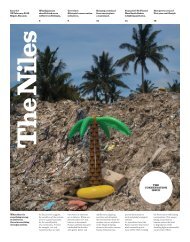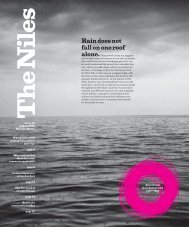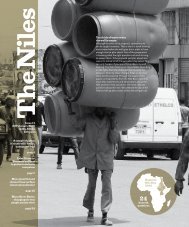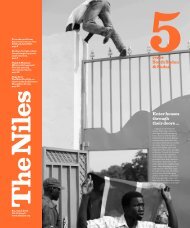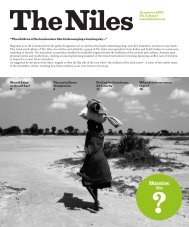A boat cannot go forward if each rows his own way
Be it to improve irrigation, manage floods and droughts or generate energy; dams have played a significant role in humanity’s progress. But the dam-building development model also has its flaws. The Niles journalists tackle the sensitive dam topic and self-aware that they all are in the same boat, they agree that it is time to start rowing the same way.
Be it to improve irrigation, manage floods and droughts or generate energy; dams have played a significant role in humanity’s progress. But the dam-building development model also has its flaws. The Niles journalists tackle the sensitive dam topic and self-aware that they all are in the same boat, they agree that it is time to start rowing the same way.
You also want an ePaper? Increase the reach of your titles
YUMPU automatically turns print PDFs into web optimized ePapers that Google loves.
TN 21
kilometres in length, with a storage capacity
of 31 million cubic metres”.
The dam
Built in 1925, the Sennar Dam is Sudan’s
oldest dam, constructed during British
colonial rule. It is located in Sennar on the
Blue Nile in the Gezira region. It is 3,025
metres long and 40 metres high. It took
ten years to complete.
The Sennar Dam was created to store and
divert water for the Gezira Scheme irrigation,
in addition to generating hydropower, flood
control and water supply.
There is no mention in the Ministry
of Environment records of any environmental
study before the dam was built, reflecting
a lack of ecological awareness at that time.
Obtaining hydroelectric power was
one of the reasons for building Sennar Dam.
Although it is considered renewable energy,
it still impacts the environment. For example,
the lake formed by the dam destroyed the
natural habitat for animals in the area.
Impeding the flow of rivers can also prevent
fish from moving freely from one area to
another. In addition, there is the risk of lethal
floods in the event of the dam collapsing,
which could kill thousands of people.
Talal Mohamed, an ecologist living in Sennar,
noted other disadvantages, including the
prevalence of diseases like Malaria, Bilharzia
and Guardia. “Those diseases are all caused
by insects living in the dam’s lake,” he said.
However, he noted the dam offers advantages.
”It is a source of income for many
people around the dam’s lake, enabling fishing
and gathering of firewood caught in the dam’s
lake. Also, many farmers irrigate their crops
from the dam’s water supply, and Sennar’s
electricity is more stable than that of many
other cities in Sudan.”
Originally designed with a capacity of
930 million cubic metres, today, it can store
only 390 million cubic metres of water, around
60 percent less, due to accumulated sedimentation
and silt in its reservoir.
As reservoir capacity was lost, channel
design became disordered, with silt blocking
major canals, minor canals and field canals.
“Modern
techniques
would
avoid [...]
the large
quantities
of wasted
water.”
During the rainy season in the Ethiopian
highlands, the vast amounts of water in
the Blue Nile lead to embankment erosion.
Besides the silt, the water carries drowned
animals, trees, and rubbish into the reservoir,
and finally to the cultivated fields, often
devastating crops.
On the way to Sennar Dam, mountains
of silt can be seen along the Gezira’s main
canal east embankment, indicating a significant
amount of silt coming from upstream
highlands.
Wubalem Fekade, the Head of Social
Development and Communication at the
Eastern Nile Technical Regional Office (ENTRO)
observed that without the Sennar Dam and
the adjacent Gezira Scheme, where upstream
sediments are caught, “there would definitely
be much more sedimentation downstream”.
The silt
Dr Younis Abdallah Gisamallah, from
the Directorate of River Engineering and
Dams of the Hydraulic Research Centre (HRC)
said that while the Blue Nile has an average
sediment load of 146 million tonnes per year,
sediments inside the Gezira Scheme accumulate
to approximately 7.5 to 8.5 million tonnes
per year.
“Efficient workers and engineers at the
Excavation Corporation and the Irrigation
Authority used 40 percent of that silt at the
beginning of irrigation, which contributed
to fertilising the soil, and then they removed
the rest professionally and without damaging
the space and volume of channels,” said
Hassabu Ibrahim, the 70-years-old Chairman
of Gezira and Managil farmers Alliance, who
lived all his life at the scheme.
In 2005, things took a different turn,
as private businesses got involved in the silt
excavation. Elsadig Ali, a farmer living in
the area, said that “companies working in
the silt removal caused a water shortage due
to over digging”, reducing the water level.
“They worked without technical guidance
and changed canal design – the depth and
width,” Elsadig explained, adding that “the
water of the canal couldn’t even reach field
channels” anymore.
Managing the silt is a delicate procedure,
as too much or too little of it causes water
shortages in the irrigation scheme. This comes
at a high cost. Officials in Sudan say that 50
percent of the operation and maintenance cost
from the ministry budget is used for managing
the sediments.
Is there a long-term solution?
Given the resources spent on managing
the sediments, and the recurrent water
shortages associated with too much or too
little sediments in the Sennar reservoir and
the Gezira irrigation canals, the search for
a long-term solution is on.
“We must change the planting times
gradually until the canals and the irrigation
network return to what they once were,”
said Ibrahim.
The agricultural engineer, Abeer Ali,
meanwhile, agreed that planting times should
be changed. She also spoke out in favour
of stopping the cultivation of crops that
consume large quantities of water, like
animal feed, for example.
Ali also recommended using modern
techniques: “Modern irrigation techniques
such as pivot and drip irrigation should be
used instead of flow irrigation,” which would
increase water application efficiency and
minimise fertiliser and nutrient loss due to
a localised application and reduced leaching.
Ali, who specialised in the field of plant
protection, pointed out that “modern techniques
would avoid the risk of harmful weeds
growing, plant disease, and would reduce the
large quantities of wasted water”.
The HRC Directorate of River Engineering
and Dams see the Grand Ethiopian Renaissance
Dam (GERD) as part of the long-term
solution. They say, once operational, the GERD
reduces the amount of sediments in the Blue
Nile and maximises the Gezira Scheme’s
irrigation efficiency.
TN
One of the two main Gezira
Canals near the city of
Al-Hasahisa.
Photo: The Niles / Mohamed
Hilali
TN15_20210310.indd 21 2021/03/10 18:29








